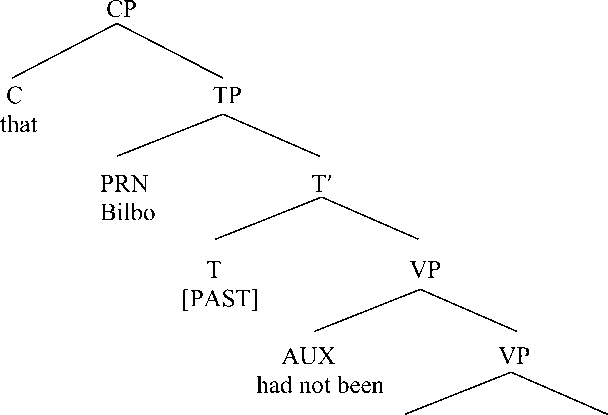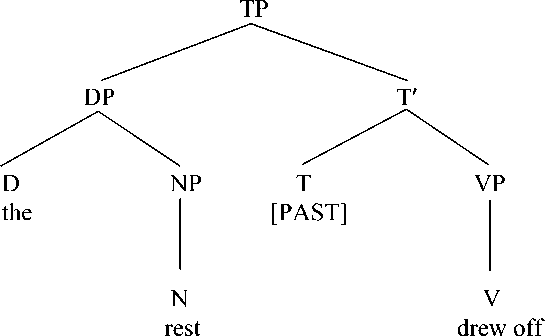The Analysis of Phrasal Verbs in the Novel “The Hobbit” By J.R.R. Tolkien
on
ISSN: 2302-920X
Jurnal Humanis, Fakultas Ilmu Budaya Unud
Vol 18.2 Pebruari 2017: 244-251
The Analysis of Phrasal Verbs in the Novel “The Hobbit” By J.R.R. Tolkien
Ni Putu Surya Eni1*, Ketut Artawa2, I Nyoman Udayana3 [123]English Department, Faculty of Arts,Udayana University 1[suryaeni95@gmail.com] 2[tutartawa@gmail.com] 3[nyoman_udayana@unud.ac.id] *Corresponding Author
Abstrak
Tujuan dari penelitian ini adalah untuk mengidentifikasi bentuk dari frasa verba (verba dalam bentuk frasa) yang digunakan pada novel berjudul “The Hobbit” yang ditulis oleh J.R.R. Tolkien dan untuk menganalisis frasa verba yang ditemukan pada novel berjudul “The Hobbit” yang ditulis oleh J.R.R. Tolkien yang ditampilkan dalam bentuk diagram pohon. Metode dokumentasi digunakan untuk pengumpulan data pada penelitian ini dengan teknik pencatatan dan metode kualitatif digunakan untuk menganalisis data penelitian. Penelitian ini menggunakan dua teori utama yaitu teori Verba Multi-Kata yang diusulkan oleh Quirk, dkk. (1985) pada buku mereka yang berjudul “A Comprehensive Grammar of the English Language” dan teori mengenai Struktur yang diusulkan oleh Radford (2009) pada bukunya yang berjudul “An Introduction to English Sentence Structure”. Hasil dari penelitian ini adalah terdapat empat bentuk frasa verba yang ditemukan pada novel sebagai sumber data pada penelitian ini. Partikel yang mengikuti frasa verba adalah“up, out, on, dan off”. Diagram pohon menunjukkan bahwa verba dan kata keterangan yang membentuk frasa verba dapat diklasifikasikan sebagai satu kesatuan yang dikatagorikan sebagai” verba” yang mana tidak dapat dipisahkan antara satu dengan yang lainnya.
Kata kunci: verba frasal, transitif dan intransitif, diagram pohon
Language is the most important thing in terms of communication. Language is used by people in everyday conversation to express feeling and emotions. Without the language, the communication would not run smoothly. According to Hornby (2010:834), language is the system of communication in speech and writing used by people of a particular country or area. The most important language to be learned is English as we know that English is an international language that is used for communicating with other people in the world. In learning English as a foreign language, we should also learn about the culture in understanding the language itself
because some of the words and utterances have special meanings and cannot be translated literally.
English, as an international language certainly has its own structures. The structure is used in classifying the patterns and the categories of each word which are formed by phrases, clauses, and sentences. Phrasal verb is one kind of multi word verbs which consist of the combination of verb and adverb as particle in the form of phrases. The meaning of a phrasal verb cannot be predicted from its individual verb and its adverb. Some of the phrasal verbs are commonly idiomatic and cannot be translated literally.
The use of phrasal verb can be found in many literary works such as novels, song lyric, articles, magazines, and newspapers. Novel is a kind of literary work used to entertain the readers. By reading novels, the reader can feel and also imagine what the story is about. Related to the topic, this study is focused on discussing the form of phrasal verbs and how the phrasal verb is presented in a tree diagram which is taken from the English novel entitled “The Hobbit or There and Back Again” as the data source. The use of phrasal verb in the novel is really interesting to be analyzed because the novelists commonly used some forms of phrasal verbs in their story. Phrasal verbs were chosen to be analyzed in this study because they are a common type of multi word verbs and the use of phrasal verb in the novel is easier to find.
Based on the background above, there are two problems that need to be discussed as follows:
-
1. What forms of phrasal verbs are used in the novel The Hobbit by J.R.R Tolkien?
-
2. How are the phrasal verbs found in the novel The Hobbit by J.R.R Tolkien presented in the tree diagram?
The aims of the study are:
-
1. To identify theforms of phrasal verbs used in the novel The Hobbit by J.R.R Tolkien.
-
2. To analyze the phrasal verbs found in the novel The Hobbit by J.R.R Tolkien presented in the tree diagram.
The study used primary data and the forms of data in this study are English phrasal verbs and their structures. The phrasal verbs were taken from one of the famous and best seller novels in the world entitled “The Hobbit, or There and Back Again”. This novel was written by J.R.R Tolkien and it was published firstly in 1937 by George Allen &Unwin in England. This novel was chosen as the data source because it is one of the famous novels and it is also coherent with the topic of this study. Besides, this novel also contains some forms of phrasal verbs and it was interested to be analyzed in order to find out the form of phrasal verbs and their structure.
The data in this study were collected using the documentation method. The techniques of collecting the data in this study were done in several steps. The first step was reading the data source closely in order to find out the form of phrasal verb used in the novel. The novel was read attentively because it was important to have a good understanding of the story. Then, the second step was to find out and highlight the phrases which were classified as phrasal verbs. The next step was identifying and selecting some English phrasal verbs found in the novel and choosing the phrasal verbs in the different forms for the data analysis. The last step was inputting the data into the computer.
The qualitative method was used in analyzing the data in this study. There were some steps in analyzing the data in this study. The first step in analyzing the collected data was identifying and categorizing the forms of phrasal verbs based on the theory of Multi-Word Verbs by Quirk et al. (1985) in their book entitled “A Comprehensive Grammar of the English Language”. Then the structure that forms the phrasal verbs
were analyzed syntactically based on the theory of Structure by Radford (2009) in his book entitled “An Introduction to English Sentence Structure” .
…they hung up two yellow hoods…(Tolkien, 1937 : 13)
The idiom hung up consists of two words formed by a verb hung and an adverb up. This idiom is categorized as a phrasal verb since it is built from a verb as well as adverb that combine together to create a new meaning. It belongs to a transitive phrasal verb because it has an object “two yellow hoods” functioning as a direct object of a verb hung up.
The Tree Diagram:
TP
PRN they
T
T [PAST]
VP
V hung up
NP
N two
N
ADJP
N hoods
ADJ yellow
The tree diagram above shows that the adjective yellow is merged with the noun hoods (its noun complement) to form the N-bar yellow hoods which is in turn is merged with two (as a noun) to form the NP two yellow hoods. The resulting NP is then merged with the verb hung up (as the phrasal verb) to form the VP hung up two yellow hoods.
Then, the T forming the T-bar is showing the past tense because the verb itself is in the past form and it is categorized as finite verb which has a function as the main verb. The T-bar then merges with the pronoun theyand forms the TP.
“Bring out the instruments!” (Tolkien, 1937 : 15)
The phrasal verb in the sentence above is bring out, it is derived from two word classes, the verb bring and the adverb out. The adverb in the phrasal verb is followed by the noun phrase “the instruments” and it has functions as an object of the verb bring out. Therefore, the phrasal verb above is categorized as a transitive phrasal verb (having an object).
The Tree Diagram:
TP
T VP
[PRES]
V DP
bring out
D NP
the
N
instruments
The tree diagram above shows that the determiner the is merged with the noun instruments to form the DP the instruments. This in turn then merged with the verb bring out (phrasal verb) to form the VP bring out the instruments which in turn is merged with the T (tense) showing the verb in the present form. The VPand T then form the TP. This subject is missing in this phrase because it is an imperative.
…that Bilbo had not been caught the dwarves went on.(Tolkien, 1937 : 115)
The bold words in the sentence above consist of the verb went and an theadverb on and it belongs to a phrasal verb. It is considered an intransitive phrase because there is no direct object that follows it.
The Tree Diagram:

V caught


D NP T VP
the [PAST]
N V
dwarves went on
The tree diagram above shows that the T (tense) causes the verb to be in the past form and it is merged with the verb went on to form the T-bar. The determiner the is merged with the noun dwarves to form the DP the dwarves. The resulting the T-bar is then merged with the DP to form the TP the dwarves went on which in the turn is merged with the verb caught to form the VP caught the dwarves went on. The resulting VP is merged with the past tense of auxiliary had not been to form the next VP had not
been caught the dwarves went on. The VP is then merged with the T (tense) that causes the verb to be in the past form. The merge of the VP and T to form T-bar which in turn is merged with the pronoun Bilbo as the subject in this clause and form the TP Bilbo had not been caught the dwarves went on. The resulting o TP is merged with the complementiserthat and form the CP.
…the rest drew off… (Tolkien, 1937 : 112)
The idiom drew off is derived from the verb drewand the adverb off which are called a phrasal verb. It is categorized as intransitive phrasal verb (without an object).
The Tree Diagram:

The tree diagram above shows that the tense is in the past form which is the verb as the main verb in this clause (finite verb) and it is merged with the verb drew off (phrasal verb)to form the T-bar. The determiner the is merged with the noun rest to form the DP the rest. The resulting T-bar and DP are then merged and form the TP.
There are four forms of phrasal verbs found in the novel as the data source. Those particles that form the phrasal verb are: up, out, on, and off.From the transitivity point of view, there are two phrasal verbs categorized as transitive phrasal verbs and there are two phrasal verbs categorized as intransitive phrasal verbs. The tree diagram
shows that the verb and the adverb that form the phrasal verb are classified as one category of verb (V)which cannot be separated from each other.
7.Bibliography
Hornby, A.S. 2010.Oxford Advanced Learner’s Dictionary; 8thEdition. London:
Oxford University Press.
Quirk, Randolpet al. 1985.A Comprehensive Grammar of the English Language.
London: Longman.
Radford, Andrew, 2009. “An Introduction to English Sentence Structure”. Cambridge:Cambridge University Press.
Tolkien, J.R.R. , 1937. “The Hobbit Or There And Back Again”. London: Harper
Collins Publishers
251
Discussion and feedback